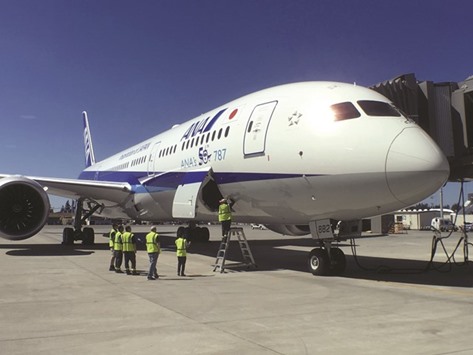ANA Holdings, the world’s biggest operator of Boeing Co’s Dreamliner jet, is checking the Rolls-Royce Holdings engines on its fleet of 787s after investigating a February incident when an aircraft had to shut down a power plant and return to the airport.
Japan’s largest airline, with a fleet of 50 Dreamliners, has cancelled nine flights with the jets Friday and may have to scrap more than 300 more through the end of September, Takeo Kikuchi, a deputy senior vice president of engineering & maintenance, told reporters in Tokyo yesterday. ANA is changing medium pressure turbine blades on the planes, Kikuchi said.
The issue, ANA’s biggest with the model since a 2013 global grounding of the entire Dreamliner fleet, came to the fore after finding corrosion on the turbine blades that had led to an aircraft having to shut down a power plant. That jet had to return to Kuala Lumpur airport after receiving a warning that the temperature of the exhaust gas from its right engine was very high.
ANA encountered the issue of corrosion in turbine blades thrice since February, Kikuchi said. Rolls-Royce will start supplying ANA with modified versions of the turbine blades from January and the carrier will replace the current blades in all its planes, Kikuchi said.
ANA, the launch customer for the 787, has been in talks with Rolls-Royce on problems with the engines since March, Kikuchi said late yesterday. ANA’s entire fleet of 787s are powered by Rolls-Royce engines. The only other engine option for customers are motors from General Electric.
Rolls-Royce shares fell as much as 2.2%, and was trading down 1.9%, as of 12:30 pm in London. Rolls-Royce said it’s aware of the ANA situation and is working with the airline to minimise the effect on service disruption. Boeing didn’t respond to an e-mail seeking comment.
The carrier has had three problems with the engines that have affected flights, Kikuchi said, adding that it expects to lose ¥55mn ($548,000) from tomorrow’s cancellations. The company doesn’t know the total financial impact of the problem at this time, he said.
All 787s worldwide were grounded for three months by regulators in 2013 after lithium-ion battery meltdowns on the jets. Boeing came up with a fix for the problem, allowing the planes to resume flights. The global grounding marked the first time in more than three decades when an entire airplane model was pulled out of service.
The same year, Japan Airlines Co, the nation’s second-largest airline, replaced 787s on two routes after Boeing ordered Dreamliner jets with GE
engines to keep away from certain
weather.
Japan Airlines, also known as JAL, uses different engines and doesn’t have any problems with them at this time, said Jian Yang, a spokesman for the carrier. The icing issue with the GE engines was resolved earlier this year,
he said.

A Boeing 787-9 jet, ready for delivery to ANA Holdings, is seen at a centre in Everett, Washington. The Japanese airline, the world’s biggest operator of Dreamliner jet, is checking the Rolls-Royce engines on its fleet of 787s after investigating a February incident when an aircraft had to shut down a power plant and return to the airport.
